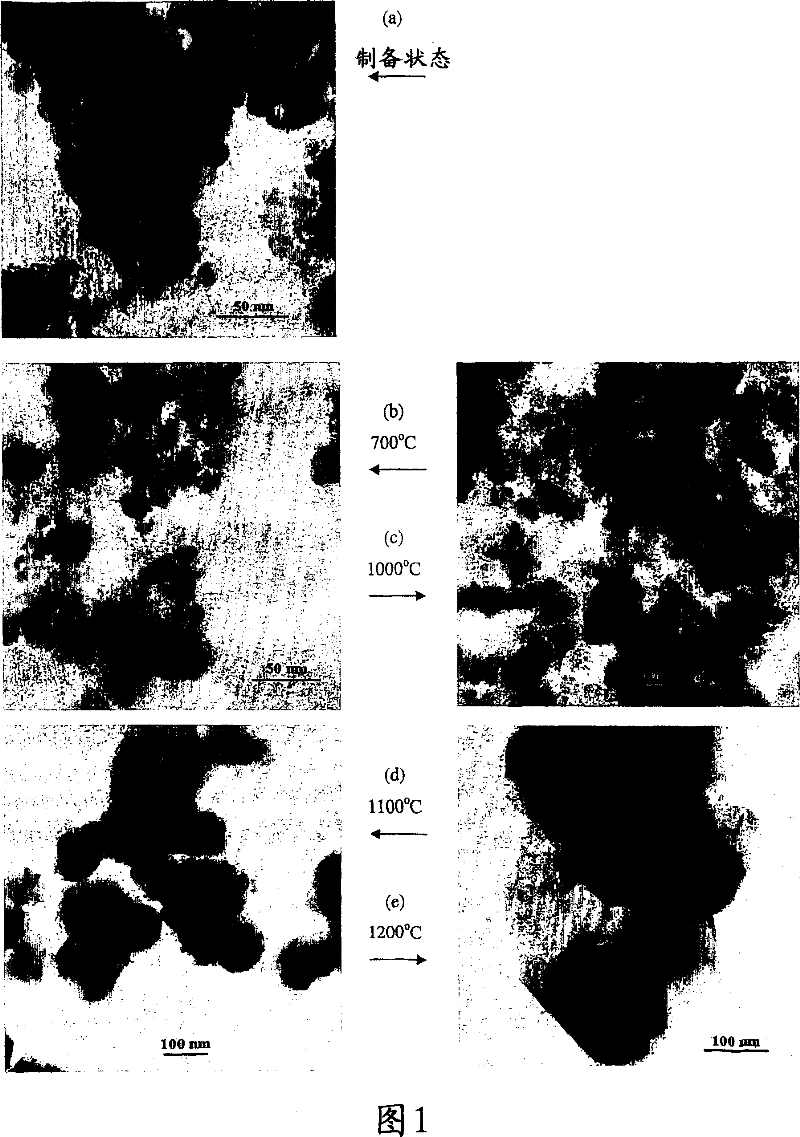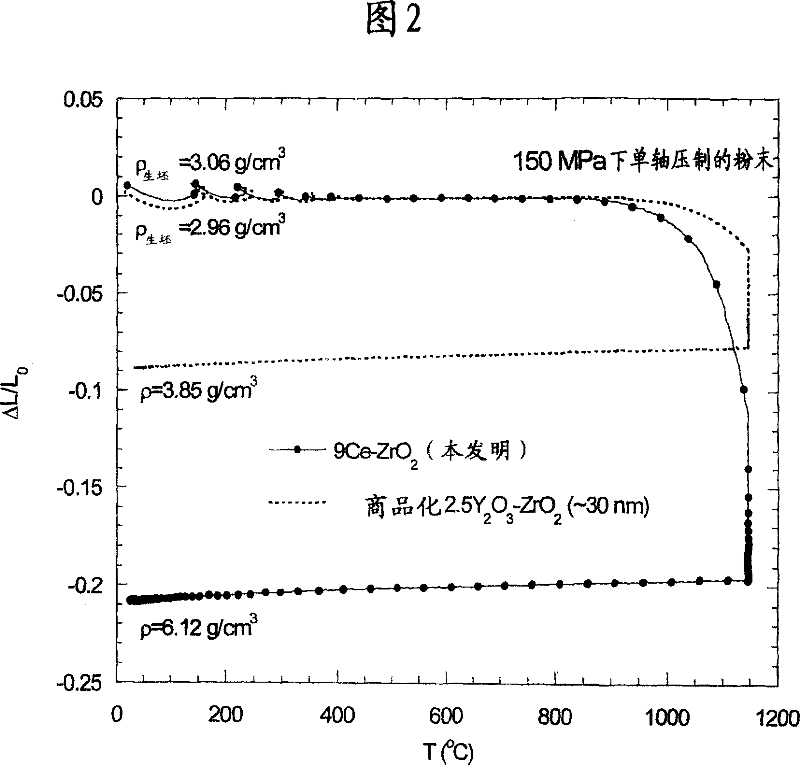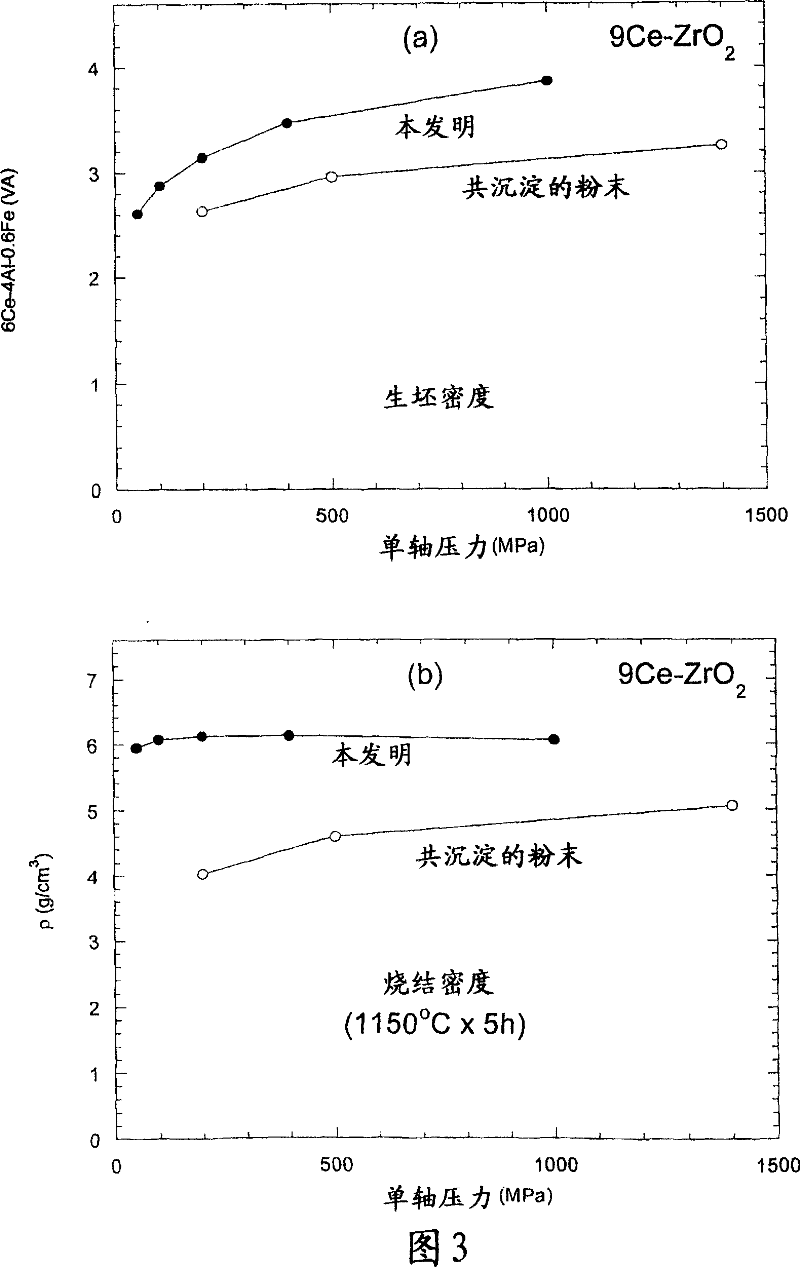A zirconia ceramic
A zirconia ceramic, zirconia technology, applied in zirconia, inorganic chemistry, zirconium compounds, etc., can solve the problems of complex, expensive, unsuitable for large-scale production, etc.
- Summary
- Abstract
- Description
- Claims
- Application Information
AI Technical Summary
Problems solved by technology
Method used
Image
Examples
Embodiment 1
[0089] Using ZrOCl as described in US Patent 6,203,768 2 .8H 2 Combination of mechanochemical treatment and precipitation of O and NaCl dilute phases produces multicomponent powders with a total cation molar ratio of Zr:Ce=91:9, the contents of which are incorporated herein by reference. to ZrOCl 2 .8H 2 O and NaCl were subjected to high-energy ball milling followed by heat treatment at a temperature of 750 °C, after which the diluted NaCl phase was removed by washing with water. The product of this first stage was a slurry of 12% by weight nano-sized zirconia particles suspended in water. The zirconia particles are kept in slurry form to avoid the formation of hard agglomerates that tend to form when the nano-sized zirconia particles are allowed to dry.
[0090] The average size of the nanosized zirconia particles in the slurry is about 20 nm, and has a relatively broad size distribution range of about 5-50 nm, as shown in Fig. 1(a). The BET surface area of the nanosiz...
Embodiment 2
[0099] In the same manner as in Example 1, the multi-component powders with a total cation molar ratio Zr: Ce: Al: Fe of 88.8: 6: 4: 1.2 and 82.8: 12: 4: 1.2 were prepared, except that before the precipitation step Add appropriate amount of Al to the feed 2 Cl 4 (OH) 2 and FeCl 3 , and CeCl 3 .7H 2 O.
[0100] Figure 5 shows the thermal expansion curves of green bodies prepared by uniaxially pressing multi-component powders at 150 MPa. 9Ce-ZrO described in Example 1 2 Compared to the curves for the multicomponent powders (shown as dashed lines), it is clear that the multicomponent powders containing Al and Fe sinter at lower temperatures. The data also show that the sintering temperature increases with Ce content. Separate sintering experiments showed that a multicomponent powder containing 6% Ce, 4% Al and 1.2% Fe became substantially fully dense after sintering at 1120°C for 3 h, while at least 1150°C was required for the other two powders to become fully dense. The...
Embodiment 3
[0102] Prepare the multi-component powder with total cationic molar ratio Zr: Ce=70: 30 in the same manner as in Example 1, except that the powder containing 20% CeO is used 2 zirconia powder instead of pure zirconia powder, adjust the CeCl added to the slurry before the precipitation step accordingly 3 .7H 2 O amount.
[0103] The green body obtained by uniaxial pressing at 150 MPa has 3.21 g / cm 3 density. After sintering at 1200 °C for 5 hours, the green body became almost completely dense (6.27 g / cm 3 ). The crystal structure of sintered zirconia ceramics is 100% cubic.
[0104] By comparison, a multicomponent powder prepared from pure zirconia particles (as in Example 1) with the same cation molar ratio Zr:Ce=70:30 could not be sintered to full density even at 1250°C because it contained too much more cerium hydroxide.
PUM
| Property | Measurement | Unit |
|---|---|---|
| size | aaaaa | aaaaa |
| size | aaaaa | aaaaa |
| size | aaaaa | aaaaa |
Abstract
Description
Claims
Application Information
 Login to View More
Login to View More - R&D
- Intellectual Property
- Life Sciences
- Materials
- Tech Scout
- Unparalleled Data Quality
- Higher Quality Content
- 60% Fewer Hallucinations
Browse by: Latest US Patents, China's latest patents, Technical Efficacy Thesaurus, Application Domain, Technology Topic, Popular Technical Reports.
© 2025 PatSnap. All rights reserved.Legal|Privacy policy|Modern Slavery Act Transparency Statement|Sitemap|About US| Contact US: help@patsnap.com



